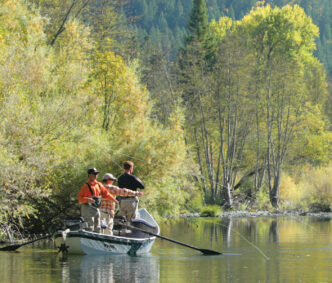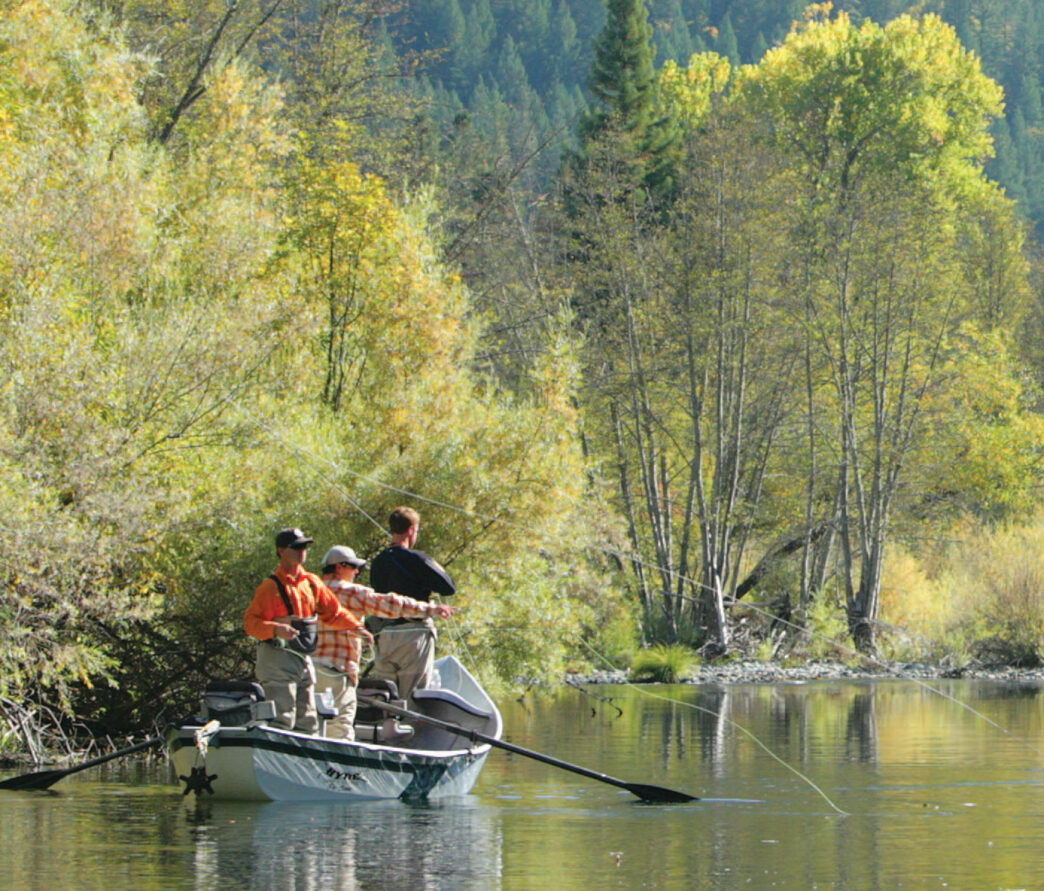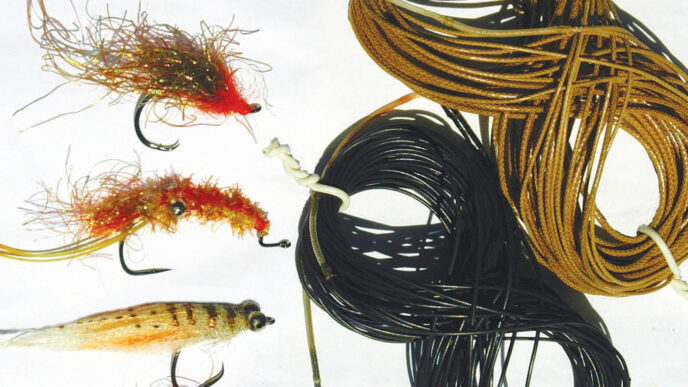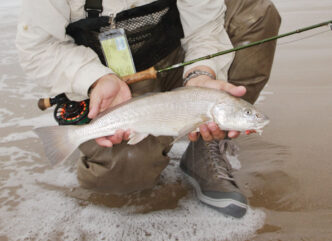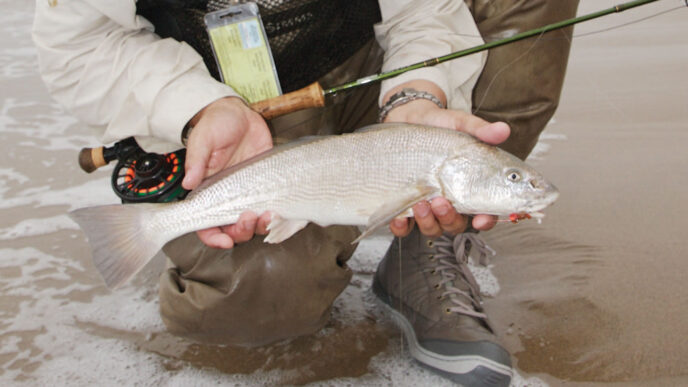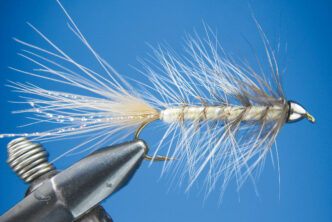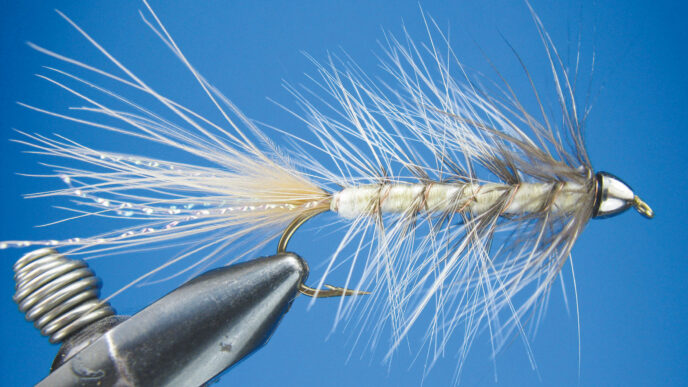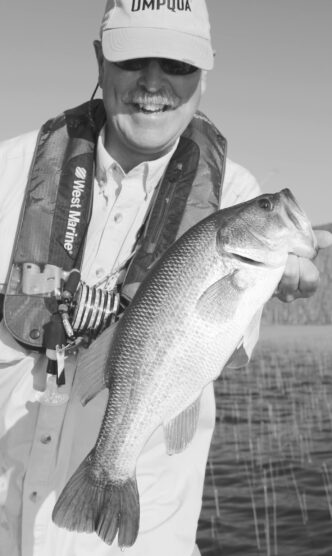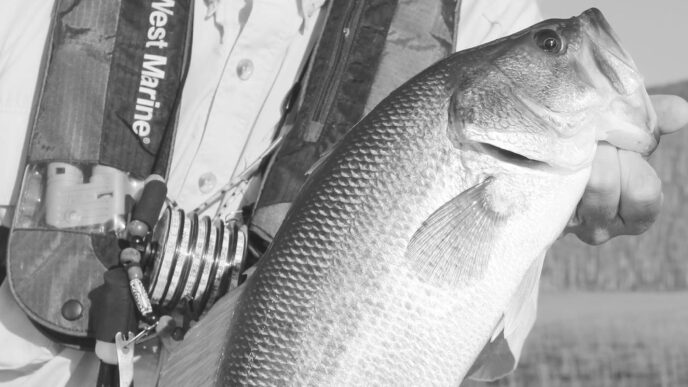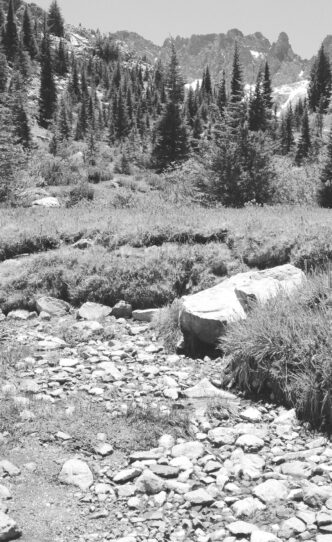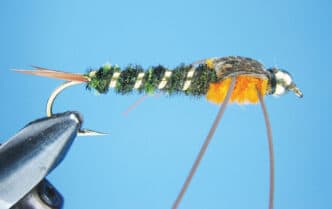I became addicted to fly fishing in 1973. I had first picked up a rod as a child, but I knew nothing about the sport. And the owner of the rod, a relative, had inherited it and knew nothing, either. In 1973, I was living in Basalt, a small town in Colorado. Little did I know that I was living close to one of the most famous trout streams in the country, the Frying Pan River. I had moved to Basalt to ski, not to fish. Aspen was just 20 miles down the road. However, knowing nothing about fly fishing, but observing the occasional fisherman on the river, I knew I must try it. I went to the local drugstore, bought a heavy fly rod, an automatic reel (why would I mess with reeling in a fish?) that was already set up with line, and a handful of colorful flies. I was ready to go. How hard could it be?
After weeks of flogging the water with few results, my fly-fishing life was about to change. It was early spring, and the sky was spitting snow. I was standing on the riverbank, watching. I wasn’t fishing, because I didn’t want to add to my frustration. Who fishes in bad weather, anyway? I curiously watched a man in the river, wading, casting. And then he caught and released a fish. As he came closer, I asked him the universal fishing question, “What are you using?” “Brown Hackle Peacock,” he replied, instinctively knowing I was no threat to his success. He paused for a moment, then shared that he worked at the local fly shop in Aspen and encouraged me to drop by. He then continued wading, casting, and catching and releasing fish. I knew I had to be a part of this. But I needed help. I needed professional help — the kind of help that only a guide could provide.
Fast forward past 40 years of fly fishing and hundreds of days on the river. I’ve had many days fishing by myself, many days fishing with friends, and many days fishing with a guide. This journey has taken me from the coastal rivers of British Columbia to the marshes of Louisiana. I was lucky to have fished great tailwaters such as the San Juan in New Mexico and the Bighorn in Montana. Also blue-ribbon waters such as the South Fork of the Snake in Idaho and the Bow River near Calgary, Alberta. I’ve lived in Northern California for the last 25 years and have been surrounded by wonderful waters. And better yet, I’ve been fortunate to have fished all these wonderful waters with great guides.
Without fail, almost all of the very best fishing days I can remember have been with a guide. I always recommend that you invest in a guide day and learn the ropes from a professional if you are venturing to unfamiliar waters. A day with a guide can be worth a month’s worth of experience going out on your own, even on waters you think you know well. If you book a guide, though, there are things you should know about being a guide’s client and about developing a relationship with the guide. It’s an encounter that may turn out to be more than you expected.
The Blind Date
The first time booking a day with a guide is like a blind date. You’ve chosen the time and place. You meet. There’s a handshake, perhaps a little get-to-know-you discussion in the truck. Maybe you need to shuttle a boat or drive to the chosen spot. The conversation, of course, moves to fishing. Once you get the mandatory “How has the fishing been lately?” out of the way, the date really starts. “What’s been working?” maybe, “How many did you catch?” and probably “Any of size?” — all icebreakers. Then the small talk is over. It’s time to get started. The guide usually has his or her own system for dropping the boat in the water, or, if it’s a walk-in destination, for getting the gear ready. I’ve learned over the years that they really don’t want your help. They have methods and systems honed over multiple efforts.
If you are away from your guide, this is when you and your fishing buddy discuss your initial observations of the guide. It’s like when your date takes her first run to the restroom. We’ve made preliminary assessments of the guide’s boat, attitude, and philosophy. Maybe we’ve checked out his or her gear and the neatness of the truck. Is the guide organized? Is there trash in the boat? Is it dirty? Maybe you’ve rigged a rod or two, if the guide instructs us to do so. If it’s an intricate nymph rig with multiple flies, often the guide likes to rig it the first time. If it’s a dry-fly or streamer rig, and the guide approves of the fly selection, maybe he or she grants permission to tie a fly on, silently hoping the knots hold and the first fish doesn’t escape.
Now everybody is in the boat, shoved off, and the guide barks out the first command. If we’re fishing a dry fly, maybe there’s a little instruction about where to cast — how close to the bank, bubble line, or seam, always with a mend. If it’s a nymph rig, you hear “OK, good drift line, mend, mend, mend, and mend some more. Oh, and by the way, your indicator is down.”
If you hook and land a fish, how does the guide handle the catch? Is he or she gentle and reverent? Or does the guide roughly toss the fish over the side, not caring enough to make sure the fish is ready to carry on.
It’s during this first stretch where the guide assesses his or her clients, as well, wondering, “How close to the bank do I need take to be?” “Should the knucklehead in the back move to the front?” “Can I trust the knot on that guy’s line?” “Should I check the rigs?”“Why is that guy back casting his indicator rig?” “Should I try to untangle it, or just cut it all off and start over?” “Does he respect my boat and my gear?”“Are they both knuckleheads?” “Is this going to be a really long day?”
And it’s in this first stretch the angler may assess the guide, asking, “Can this guy row?” (if it is a guy), “Is he thinking, or just going through the motions?” “ Will he adapt?”“Is he engaging, or would he rather keep quiet?” And “Is he looking like he needs a nap and a shower?” “Is he easy to talk with, or do I have to pry words out of him?” “Does he know his bugs?” “Does he explain things?”
Both parties are hoping that some reasonably good numbers of fish will be caught, relative to the conditions. Unfortunately, the measure of a guide is often assumed to be only how many fish were caught. If a client thinks 20 fish days are normal, expectations have to be managed. When anglers invest in a guide day, they expect to catch more fish. The client hopes the guide takes the guesswork out of the river and that all a client has to do is cast and land fish. Conversely, the guide hopes the client can cast and has a sense of what we’re trying to do together. Both have high hopes for a good first date.
The Second Date
Clients who have had a good day with the guide may book another day. As on a second date, they know each other a little better. The jitters are out of the way, and each now has a sense of who the other is and what they are capable of as a fly fisher and a guide. The talk is friendlier, and perhaps a genuine interest in each other’s lives has taken place. “How is the family?” “How is work?” “How’s the fishing been?” “Any different bug life?”“Any funny stories with other clients?” And if the second date goes even reasonably well, the guide and the client will have established what can turn into an ongoing relationship.
The Relationship
At this stage, each is comfortable with each other. This, to me, is as good as it gets between a guide and a client. The guide knows what the client likes to eat, how the client fishes, and about the client’s family. Although it is still a working relationship, it feels more like a day with a friend — and it really is. Fishing becomes secondary to hanging out with good people. Both parties look forward to the day. Any anxious expectations that may have accompanied the first encounter are stripped away, knowing that both will have the best day possible under the current conditions. Disappointment isn’t an option. Nobody worries about what happened yesterday, and everyone focuses on the potential of today. The guide trusts the client, and the client trusts the guide. They may hang out together now, on and off the water — grab a meal, drink some wine, smoke a cigar, and laugh at themselves. A friendship has been forged over the love of fly fishing and respect for its processes — and respect for the people who think enough of it to do it for a living.
Lessons of Experience
If all goes well, fishing with a guide is the pinnacle of the angling experience. To me, the best guides fish you to your limits. Roll your dad, your favorite teacher, and your best fishing buddy all in one and out pops the perfect guide. Of course, no one is perfect, and we’ve all had bad days. Guides are no exception to that.
While I’ve respected and admired many guides, I would recommend that others turn a new page in their career book. I’ve fished with guides so disinterested in the day and the float that it was obvious they were daydreaming about the take-out while still sitting at the put-in. Some were so hungover that any movement or noise set them off, chumming over the side of the boat, sharing their breakfast with the fish. Here are some experiences I’ve had with guides over the years: war stories, in part, but instructive stories that also point to one or more morals.
I Just Have to Laugh
I’ve had a few experiences that may have not been too funny at the time, but that looking back, make me laugh a little. One time, a group of us were fishing for steelhead on a California river. We had rotated guides, and two of us were slotted to take our turn with an old veteran of the river. He wasn’t pretty, but he really knew this water. First, he was late. Not just a few minutes late, but an hour late. When he arrived at the river, he was seriously hungover — not just a little, but world-class hungover. We managed to get the boat in the water, and then this robust fellow attempted to put on his waders. He either had grabbed his little sister’s waders or had gained about 50 pounds overnight. We stood and watched him stuff himself first into one leg, then the other, plumber’s crack in full view. If you’ve ever stuffed sausage casings, this was very similar. Not able to get the suspenders over his shoulders, he settled for some sort of fastening and called it good, the whole time fighting the saloon flu and a greasy breakfast. Finally we got into the boat and were on our way, now about two hours behind. We managed to get a few grabs, land a few fish, and all in all, made it a good day. The best part about most of my fishing buddies is that they take these days in stride. The story caused many laughs that evening while enjoying our own beers and a whisky or two.
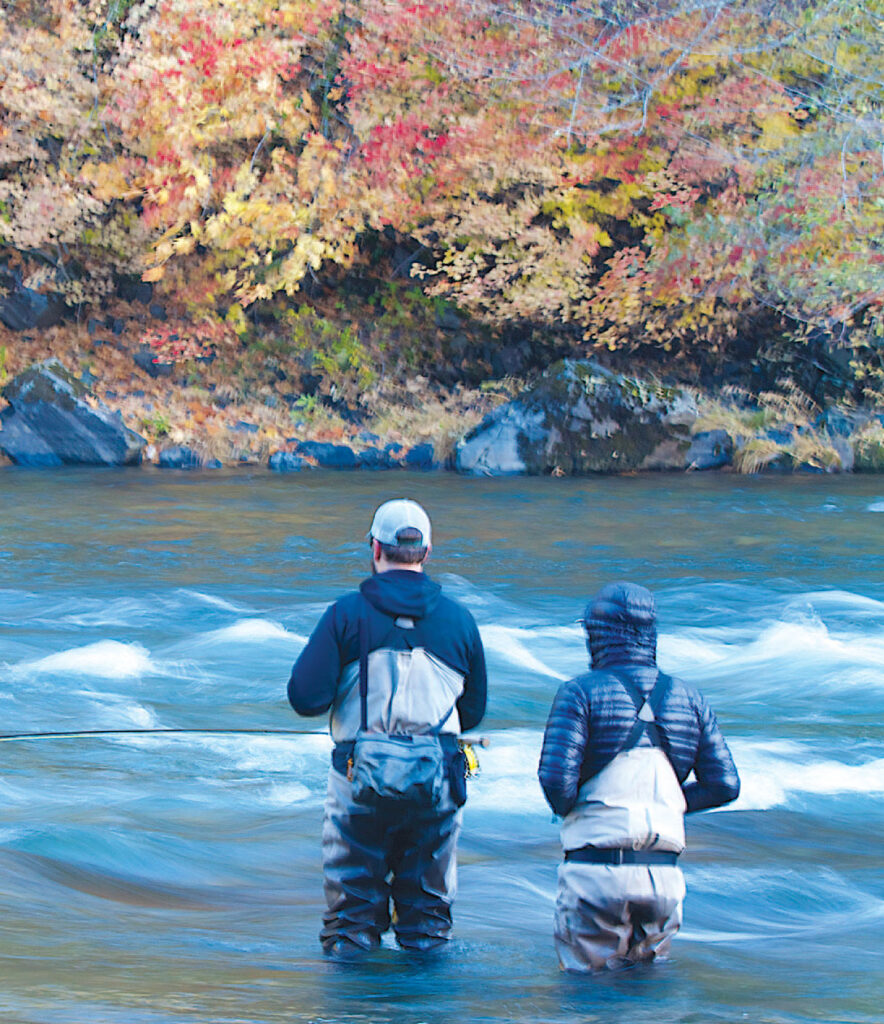
I was once part of a big group on a steelhead trip to British Columbia. I think our group was a little larger than normal for the lodge, and a few extra guides were called in to help. The trip was a week-long, so each duo would rotate through and fish with a different guide each day. Many of the large coastal rivers there are fished with jet boats, and this guide had a particularly nice one. We jetted upriver to our spot, and the guide instructed us where to stand and start casting. He then pulled out a monster spin-fishing rig with a large lead triangle weight on the bottom, sprouting two or three treble hooks off the stem. On each was a chunk of bait. He asked, “You don’t mind if I throw this off the back of the boat, do you?” I don’t judge anyone by the gear they use or the fishing method they choose. However, if the guide is guiding fly fishers, one may expect him to focus on the clients and the method with which they are fishing. I’m not sure what he was hoping to catch, but nothing attacked his offering. I was glad for that.
Hey, They’re Not Babysitters
On the other hand, sometimes the guide can be rock solid and their clients are idiots. A client who is a know-it-all immediately looks for the flaws in the guide, when really, the flaws lie with the client. On one trip in my early years of fishing, I had booked a visit to the Missouri River out of Helena, Montana. My fishing buddies at the time were commercial airline pilots. We needed six anglers to complete the party, however, and the pilots knew other pilots who were supposedly fly fishers, too. So off we went to Helena in mid-October to meet up with our guides.
The first day on the Missouri, we had nice weather and no wind — a perfect fall day. All but one of us caught fish. The fish were working the weed beds, and a quickly stripped Matuka often produced results. Day two was the same — the sun shining, temperatures in the low 70s, fish working the beds, fish being netted — again, all except for one angler.
So after two days of no fish, this fisherman (from Texas, it turned out), started badmouthing the guides. “They’re terrible and don’t know anything.” “We shouldn’t pay them and certainly not tip them.” I didn’t really know this fellow, but gave him the nickname “Skunk.” At first it was a term of endearment, but it turned into a prediction. Could this be a punishment imposed by the fishing gods?
On day three, we awoke to a blizzard. It was snowing sideways. The guides met us at our hotel. They decided it was too dangerous to float and that we should do a walk-in somewhere. They agreed on an area and said they’d be back to get us all in an hour and we should be ready to go. Meanwhile, Skunk had been hitting the hot chocolate and schnapps. After a couple of these, he was pretty well lubricated.
The walk-in spot was about a 45-minute drive from Helena toward Great Falls. It was still snowing, and most of us were properly layered against the elements — everyone except for Skunk. He had a pair of flyweight waders, like a plastic grocery bag. A strong breeze would tear them, and neither they or his undergarment offered a buffer between cold and the body. His upper body wasn’t covered much better.
We got to the river, walked down from the van in ankle-deep snow, and started to fish. I was first in, and my first cast I got a grab — a surprise, really, because I wasn’t confident this would be a good day. Soon Skunk had made it down to the water. The guides had realized that he was a little tipsy and that they should keep an eye on him, first for safety and second because he was becoming vocally abusive toward the guides.
Soon, a guide bolted off the bank and rushed toward Skunk, who had managed to wade in over his waders. The guides brought him in, set him by a fire that was burning in a 55-gallon drum by the nearby railroad tracks, and changed out some of his clothing. He began sobbing by the fire. On day four, the last day of the trip, Skunk got to float all by himself with one guide in a smaller raft. He never did land a fish in our four days on the river. Despite the guides trying their best, he had no respect for them or for the sport.
Boat Mates
Sometimes a good guide can have clients who are not jerks and who know how to fish, but that doesn’t always mean that things will go well. Like a hunting buddy, boat mates must work well together. Casting rhythm, with both clients in a drift boat alternating their casts in cadence, makes for a great float. But the guide is focused on the drift, on avoiding hazards, and on the flies on the water and can’t predict when both anglers might cast at the same time, nor can the guide punish the guy in the back for letting his fly drift out in front or when the front angler lets his bug languish behind. It always helps when the person in back calls out when he or she is casting. Simultaneous casts can result in midair line collisions and knots that even the best guide can’t untangle.
And equal abilities make for a better float, too. If the person in the front can cast only 25 feet and the one in the rear a little farther, you may see the guide angle the boat so the front angler is a little closer to the bank. It makes it a little easier for the angler in the front.
The Dreaded “Show Me” Cast
Many times, I’ve asked a guide to demonstrate the cast they’d like to see me make. I’ve had friends do the same. Often, the guide is very hesitant to do that. If the guide demonstrates the cast, it doesn’t always work out well for the guide, because if the guide catches a fish on that cast, and the client has a poor day, the guide just caught the client’s fish.
If the situation presents itself, and my boat partner agrees, we’ll ask whether the guide would like to fish, cast our rods (if different from the guide’s gear), or determine by casting if the rig the guide has recommended is fishing correctly. For me, if the guide catches a fish, it’s all the better, because it means that the way we’re fishing is working. But, that doesn’t always sit well with all anglers.
The Food
I like to cook, so I’m a little harsher critic than most clients of the food supplied by guides on float trips. And I require a lot of fuel. Although the food shouldn’t be the main attraction on a guided trip, it’s important. It adds a layer of care and quality. With guides I’ve fished with before, with their permission I’ll bring something from my own kitchen — just a little added bonus. If it’s cold, how about something hot to drink or eat? Soup tastes really good when it’s raining. How about hot tea or coffee? Good sandwiches are super. Maybe add a pasta salad or a side of veggies. Fruit works. Think about a homemade cookie or energy bars. Mixed nuts are always a great mid-afternoon snack. Bring plenty of food. Pack plenty of water. A good meal on the river can cover up poor fishing. Conversely, with a bad meal on top of bad fishing, you might as well go home early and hit Mickey D’s on the way in.
The food doesn’t have to be fancy, just good. It’s obvious when a guide stops at a convenience store and grabs a bag of chips and a couple of those triangle white-bread sandwiches, the kind with a paper-thin single slice of turkey, slathered with a nasty mayonnaise-type coating. Every time I get one of those sandwiches, I’m amazed they even make food like that anymore. There’s nothing worse than being hungry with four hours remaining on a float and the guide has nothing left but a half-empty bag of old potato chips.
I heard a funny food story — funny because it didn’t happen to me. The guide had announced he had made BLTs for lunch. With much anticipation, the client bit into the sandwich. Lo and behold, the bacon had not been cooked. The guide put raw bacon on the sandwich. Maybe he ran out of time or just didn’t know, but needless to say, the clients went hungry.
A Great Day on the Water
The moral of all these stories? There are several. For a great guided day on the water, it’s important for everyone do their part. But also, be able to make adjustments and be flexible. Treat the guide in his or her work as you would like to be treated in yours. Be on time, communicate about the day, and be realistic about the fishing and your abilities. Be honest with the guide about your experience level. A good guide is a teacher, but has to know what to teach — and when. A good guide is an encourager, not a critic. He or she will focus on what you do right, not what you’re doing wrong. So head out with an open mind. Be prepared to learn. Be courteous and respectful, both of the guide and the water you’re on. And tip your guide generously. Done right, this is very hard work.
Remembering Bill Lowe
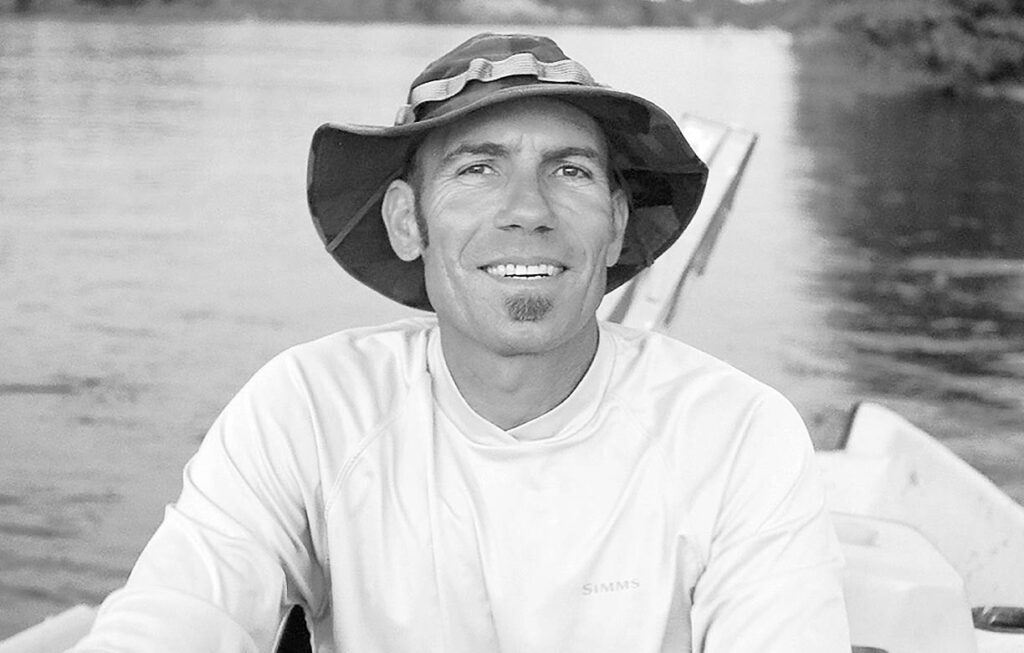
BY KURT COLGAN
Friend and guide Bill Lowe passed away suddenly on May 5, 2014. Bill was doing what he loved. He was guiding a float trip and floating on his favorite river, the Yuba.
I’ve been lucky most of my life to meet really cool people in really cool places. Bill Lowe was one of the coolest. My relationship with Bill started with fly fishing, but evolved into a friendship that was so much more. Once or twice in a lifetime, we come across extraordinary people who make us much better people ourselves. Bill was one of those people. Everyone he met was better for it. A student of the sport, Bill had a great knowledge of the bugs, the gear, and what method would have the best chance for angling success. Bill was more of a professor than a student, a Ph.D. in fly fishing. He was a renowned casting instructor and consultant to many fly shops and manufacturers.
I remember Bill’s response to an angler who indicated he wanted to keep a fish to eat. “They are tasty, but you’re really eating my business partners. Without the fish, I’d have no work.” Bill taught us that every fish matters. No matter what size, each one is important. He released his fish with care. If you wanted a photo, you needed to be ready and do it quickly. If you were too slow, the fish was back in the water. “Sorry — you’ll just have to catch another.”
Bill’s boat was always clean and organized, and his equipment was first-rate. For some guides, the job is work, but for others, the work is pleasure. We caught fish — as many as we were supposed to, I figured. But while catching fish was fine, hanging with Bill was the real treat. For Bill, each trip was a time to teach. Great teachers are great encouragers. Bill was the best. Bill always told me what I was doing right, followed by a tip or two. Some guides will yell at you and focus on what you did wrong. No repeat trip for me. When we had Bill booked, we knew we were in for a great day. It could have been raining, windy, very slow — it didn’t matter. The day was always great. Some of Bill’s advice: “If you cast in front of the boat, your buddy can fish too.”
Or, “In all my years of fishing, I’ve never seen a fish caught with a cast like that, but you never know, it could happen.” For me, the saddest part of the day was seeing the takeout come around the corner. Bill enjoyed himself too, but was happy the day was over so he could get home to his best friend and bride, Michelle.
Bill always took a keen interest in what we wanted to discuss. It could be real estate, family, food, even a persistent rash — he was interested. He always made me feel whatever I wanted to talk about was important. He was very willing to share fishing tips. For him, there were no secret spots, secret bugs, or “I’ll show you if you book with me.” No “You should have been here yesterday.” Bill was never threatened by sharing real fishing advice. He knew we’d float again, wade, and cast.
So we do our best to go on without Bill. We take what Bill taught us and move it forward. We quote with confidence his expressions. All our bugs are bitchin’ and our ideas are right on every time. We are stoked to live every day, and we hug like it’s our last. We have nicknames for everyone, and they are always terms of endearment. I’m Captain Colgan, forever. He’s Billy Bob to me. Tight Lines Brother Bill. Hope they’re rising every day where you are.
Friends and relatives have set up the Bill Lowe Memorial Trust. The trust is focused on providing opportunities for inner-city and underprivileged kids to learn about fly fishing and conservation. To donate, contact Merrill Lynch, 2320 East Bidwell, Suite 100, Folsom CA 95630 and designate the trust.



